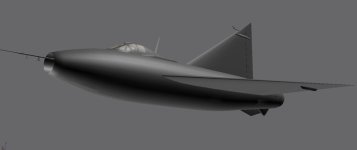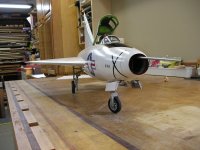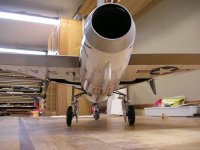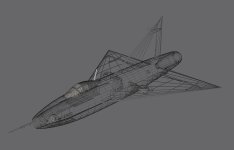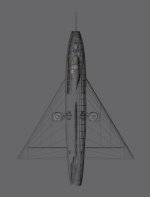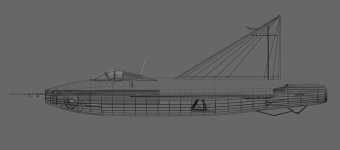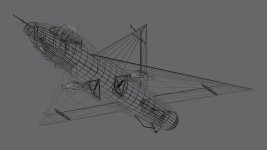-
There seems to be an uptick in Political comments in recent months. Those of us who are long time members of the site know that Political and Religious content has been banned for years. Nothing has changed. Please leave all political and religious comments out of the forums.
If you recently joined the forums you were not presented with this restriction in the terms of service. This was due to a conversion error when we went from vBulletin to Xenforo. We have updated our terms of service to reflect these corrections.
Please note any post refering to a politician will be considered political even if it is intended to be humor. Our experience is these topics have a way of dividing the forums and causing deep resentment among members. It is a poison to the community. We appreciate compliance with the rules.
The Staff of SOH
You should upgrade or use an alternative browser.
Convair Delta Wing Test
- Thread starter Milton Shupe
- Start date
Sundog
SOH-CM-2025
So it was the fish that carried over into the hyper-sonic era and not kingfish. Interesting. Well, thats perhaps a conversation for another thread. Kingfish is dead, long live the fish. It's also interesting to see how Kingfish was based on the delta dagger ( but ended up being a tiny bit more like the F-117 ). I dont know what all that misdirection and misinformation was at the end of part four there, but it stinks to high heaven of American propoganda.. Time will maybe tell.. Thank you Rick..
The Fish predated the Kingfish. There were many different design studies of the Fish. It was designed to be launched from the belly of a B-58. Some of them had launch boosters. Then when Oxcart came along, they scaled it up so it didn't need to be launched from another aircraft and reworked it to meet the requirements and it became the Kingfish.
In fact, the Kingfish beat the A-12 in the first review, because of it's stealth. The CIA demanded stealth, but Kelly Johnson didn't want to use any stealth because he thought very high speed was enough of a refuge. The Skunk Works original submission (A-11?) was designed for Mach 4. But when Kelly heard they were losing to Convair, he relented and added stealth and the A-12 was born. There are reports that they were evenly matched, but the A-12 had slightly better range. But I think the Kingfish was designed for Mach 3, whereas the A-12 was based off of a Mach 4 design and in testing the A-12 hit around M=3.72 and the SR-71 about M=3.68. But they were limited operationally to a max of M=3.5. Anything over that destroyed the powerplants, but IIRC, during the first mission over Hanoi they were allowed to push it just past M=3.5 due to our concern over all of the SAM sites circling the city.
The main thing with deltas is limited control power since they can't be trimmed out at higher alpha (Unless you throw a tail on it; see the MiG-21 and the F-16), high induced drag at high alpha due to the vortex shed off of the apex (Think fore-runner of strakes) but structurally efficient (due to the low aspect ratio; big root chord with high taper ratio, small span), low drag at high speed due to the high L.E. sweep. Oh, and they look cool.
Another weird characteristic of deltas is you have to be steady on alpha and power during approach, because you can develop a sort of PIO due to being off-speed and off alpha. You see, if you get a little too slow or have too high of a decent rate most people want to pull back on the stick to create higher alpha and more lift. In a delta you will get a brief increase in lift, but then the higher drag of being at higher alpha kicks in and you also have less lift because you have more negative camber in the airfoil (elevons deflected further t.e. up) and the aircraft will sink even more. Conversely, if you are too nose up and push forward on the stick, you will reduce drag and it will want to "balloon/float" up initially due to lower drag and since the elevons now have less t.e. up and the camber develops more lift. The test pilot of the Arrow talked about that in one of my books on the Arrow program. If you aren't on alpha and at the correct power/speed for approach, just add power and go around and try again.
Also, I have a very good article on the history of the XF-92 which mentions where various parts of the plane were taken from, such as the landing gear, etc., if you guys are interested. Just PM me.
Thanks for modeling this, it's another plane I can cross of of my FS bucket list.
Very interesting Sundog. But I have a question. When I got to fly the C-17 simulator, the instructor made a "big deal" out of the fact that the C-17 lands "on the back side", meaning on the back side of the power curve, a high AOA (low speed) region where forward and aft stick movement affects speed (AOA) and power controls glide slope (altitude). It's the same place on the power curve where navy jets approach the carrier, which is why they fly approaches the same way. Since all these delta-wing jets land at high AOA, might they "simply" be operating "behind" the power curve on approach, like C-17s and F/A-18s? I do wish FSX (etc.) modeled this interesting behavior better!
Bjoern
worst developer ever
Since all these delta-wing jets land at high AOA, might they "simply" be operating "behind" the power curve on approach, like C-17s and F/A-18s? I do wish FSX (etc.) modeled this interesting behavior better!
Try Restauravia's Mirage III series. Since pilots of the real thing were involved in development, it handles pretty damn convincingly using only what's offered by FSXA.
Sundog
SOH-CM-2025
Very interesting Sundog. But I have a question. When I got to fly the C-17 simulator, the instructor made a "big deal" out of the fact that the C-17 lands "on the back side", meaning on the back side of the power curve, a high AOA (low speed) region where forward and aft stick movement affects speed (AOA) and power controls glide slope (altitude). It's the same place on the power curve where navy jets approach the carrier, which is why they fly approaches the same way. Since all these delta-wing jets land at high AOA, might they "simply" be operating "behind" the power curve on approach, like C-17s and F/A-18s? I do wish FSX (etc.) modeled this interesting behavior better!
As Rick said, the backside of the power curve is normal for all aircraft. It''s basically a plot of drag and available power. It's usually noticeable on landing because you're in a high drag low power configuration. If you remember that old video of the F-100 where the pilot comes in too slow and he tries to correct by pulling the nose up and only gets slower then finally stalls and rolls into the ground. Basically it's where the drag generated is higher than the power available. Modern aircraft usually have enough excess power that they can add smash and fly out of it. The F-100 didn't have that much power available at low speeds. The pilot got slow and tried to compensate with more alpha, which lead to even more drag, and he really didn't have any way out since they didn't have zero-zero ejection seats in those days.
Here's a graph of it. Power available is what your powerplant produces and power required is the total drag curve. When you get to the left side where the power required (drag) is higher than the power available, that's the backside of the power curve. Most aircraft will stall before they get into this region of the envelope.
What I'm talking about with regard to the delta is basically how the flight controls which control pitch also effect the camber of the wing. With a tailed aircraft, you push the stick forward, the tail lowers the nose (alpha), the wing is at lower alpha and if density and speed (dynamic pressure) remain constant, you generate less lift. With a delta, you push forward on the stick, which will push the nose down, and lower alpha, which lowers lift, but it will also increase lift because you've just increased the camber of the airfoil. The exact opposite happens for pitching up.
At small increments of alpha, the higher dynamic pressure means you don't have to deflect the flight controls much, so the camber change is most likely negligible, but based on what I've read of most deltas, it's really noticeable at low speeds and high alpha, such as on approach to landing.
Update: invested the last three days getting the nose and main gear started and doors and bays cut in.
Now that the basics are done, I can clone to the right side, add details and animate.
I'll be another day on main gear and associated fuse and wing parts.
Attachments
Sundog
SOH-CM-2025
Interesting topic and discussion guys. Just curious who has the knowledge and skills to do the flight model
I never looked at how they did the Concorde FM, but I'm betting if anyone has experience with how to implement a good delta FM, it's Glowing Heat (maybe he'll offer some advice). I've made some FM's before and for jets, I find the most difficult part is finding a good engine deck to reference. I only have a couple of them. I don't recall the FDE having a delta option and I've been thinking about how you make it work. Do you make the wing and elevator "overlap" and artificially reduce the parasite drag based on the actual surface area as opposed to the doubled control surface area the sim would see? Do you also model them as flaps, to effect the wing lift as they are deflected as well?
I'll be more than happy to help out where I can, but between guitar lessons and practice, working around the house (too many projects), and writing a book with a lot of graphic art I have to complete, my calendar is full. Also, once a month I have to make the news letter for the model hobby club I'm in (Will-Cook IPMS). I mean, it's so bad, the only thing I assemble in the hobby club right now is the news letter. Here I thought I would finish my 1/72 Sukhoi PAK-FA/T-50/Su-57 before the end of the year.
The preview shots look great so far. Of course, I'm never surprised by that from you.
heywooood
Mayor Emeritus of Taco City
Attachments
I never looked at how they did the Concorde FM, but I'm betting if anyone has experience with how to implement a good delta FM, it's Glowing Heat (maybe he'll offer some advice). I've made some FM's before and for jets, I find the most difficult part is finding a good engine deck to reference. I only have a couple of them. I don't recall the FDE having a delta option and I've been thinking about how you make it work. Do you make the wing and elevator "overlap" and artificially reduce the parasite drag based on the actual surface area as opposed to the doubled control surface area the sim would see? Do you also model them as flaps, to effect the wing lift as they are deflected as well?
I'll be more than happy to help out where I can, but between guitar lessons and practice, working around the house (too many projects), and writing a book with a lot of graphic art I have to complete, my calendar is full. Also, once a month I have to make the news letter for the model hobby club I'm in (Will-Cook IPMS). I mean, it's so bad, the only thing I assemble in the hobby club right now is the news letter. Here I thought I would finish my 1/72 Sukhoi PAK-FA/T-50/Su-57 before the end of the year.That's all after my day job. So I can help, it just won't be quick.
The preview shots look great so far. Of course, I'm never surprised by that from you.
Sundog,
I wasn't really asking; just commenting in jest.
The plan right now is I'll do a basic FM for testing.
Then I'll turn it over to Rick to deal with
I am doing this project for Rick and he will take it where he wishes once I am done modeling.
Thanks
Milton
Sundog
SOH-CM-2025
Sundog,
I wasn't really asking; just commenting in jest.
The plan right now is I'll do a basic FM for testing.
Then I'll turn it over to Rick to deal with
I am doing this project for Rick and he will take it where he wishes once I am done modeling.
Thanks
Milton
:: phew::: That was really going to work on my time management skills!
:: phew::: That was really going to work on my time management skills!
LOL Sir; I appreciate that you are always willing to help.
Brent Stolle did a fantastic FDE for the MTM Mirage 2000C. Maybe if you intrigue him enough?
Good point Dimus; he would be good. Bernt usually contacts me when he has an interest. Not sure if Rick has anyone in mind or not but I'll leave it to him to sort out.
this is a scratchbuilt balsa display model - rayl is an active contributor at the VA website - he may have some interesting plans and photographs to share. I dunno about FM's though...but certainly drawings and pictures etc..
Very well done model; looks great.
I will not be needing drawings or ref pics unless there is something available for the cockpit. Everything is done. Thanks
Mach3DS
Charter Member
Bjoern
worst developer ever
I never looked at how they did the Concorde FM, but I'm betting if anyone has experience with how to implement a good delta FM, it's Glowing Heat (maybe he'll offer some advice). I've made some FM's before and for jets, I find the most difficult part is finding a good engine deck to reference. I only have a couple of them. I don't recall the FDE having a delta option and I've been thinking about how you make it work. Do you make the wing and elevator "overlap" and artificially reduce the parasite drag based on the actual surface area as opposed to the doubled control surface area the sim would see? Do you also model them as flaps, to effect the wing lift as they are deflected as well?
Engine data may be a bit of a problem, but the J33 allows extrapolation from data for other aircraft (T-33, P-80, etc.).
No point in defining a delta planform in the FDE when you need to determine its aerodynamic characteristics by coefficients (C_L, C_d, etc.) in the .air file and aircraft.cfg anyway. Same for elevator influences in terms of pitch acceleration, moment and drag increase.
FSX flight dynamics reference (minus engine-related things): http://fsdeveloper.com/forum/resources/flight-dynamics-in-msfs-v1-0.169/
The worst thing about making FDEs is having to fill gaps (usually a lot and very wide) in source data with a lot of time-consuming trial and error.
Some charts containing aircraft characteristics are displayed in this video:
https://www.youtube.com/watch?v=2HKQ87g4SsQ


